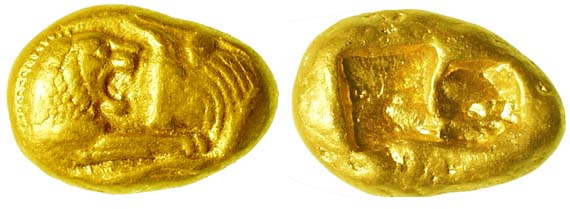
Most historians think the city-states of Greece and kingdoms of Asia Minor invented the first coins in the 7th century B.C. The Kingdom of Lydia, in present-day Turkey, stamped lumps of precious metals with an official seal to guarantee their weight and purity. Lydian metal, stamped with King Croesus' seal, became something everyone accepted. Public confidence in the King's money gave trade a great boost. These Lydian coins called STATERS, were first made of electrum, an alloy of gold and silver. About the size of a finger nail, these first coins were valuable. But, the mix of gold and silver was unpredictable, making some electrum staters worth more than others. Eventually, the Lydians stabilized the stater by minting two versions, one gold and one silver. This change produced the world's first bimetallic standard. The front of Croesus' coin is stamped with a growling lion's head facing the head of a horned bull. In ancient Mediterranean cultures, the bull was a symbol of strength and heroism. The lion may have been Croesus' tribute to an ancient symbol of a maternal divinity.
Continue